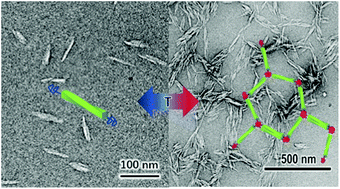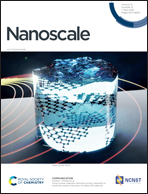Temperature-triggered formation of a cellulose II nanocrystal network through regioselective derivatization†
Abstract
The two ends of rodlike cellulose II nanocrystals (CNC-II) were regioselectively functionalized either with gold nanoparticles or thermosensitive polymer chains. In the first case, after the introduction of sulfur atoms at both ends of the rods, CNC-II were labelled using a method based on the in situ nucleation and growth of gold nanoparticles (AuNPs) from soluble derivatives. Transmission electron microscopy (TEM) images showed that such a method resulted in the grafting of one monodisperse AuNP at each extremity of the CNC-II, i.e. to the formation of hybrid dumbbell-shaped objects. No AuNP was detected on the lateral surfaces of the CNC-II and almost all observed CNC-II exhibited this dual labeling. This result confirmed with a good statistics when compared to previous works the possibility to derivatize only the two ends of the CNC-II, thanks to the antiparallel arrangement of cellulose chains in these nanoparticles. In the second case, the localized grafting of temperature-sensitive macromolecules onto the ends of the CNC-II was performed using an oxidation reaction followed by a peptide coupling. This end-specific grafting of thermosensitive chains onto CNC-II enhanced their colloidal stability when the temperature was below the lower critical solution temperature (LCST) of the polymer. Above the LCST, the TEM images revealed the formation of a network extending to tens of microns resulting from end-to-end associations of the derivatized rods through attractive interactions between collapsed polymer chains. Rheology experiments further evidenced a temperature-induced sol–gel transition from a liquid-like (sol) behavior below the LCST to solid-like (gel) behavior above the LCST, in agreement with a change from purely repulsive interactions to interconnections via the hydrophobic collapsed chains. Importantly, all results concurred with a full reversibility of the phenomena upon cooling and reproducibility when samples were subjected to temperature cycles around the LCST. This work reveals that the dual site-specific derivatization of CNC-II can provide symmetric hybrid particles with innovative assembling and macroscopic properties that cannot be obtained through homogeneous chemical modifications.

- This article is part of the themed collection: 2021 Nanoscale HOT Article Collection


 Please wait while we load your content...
Please wait while we load your content...